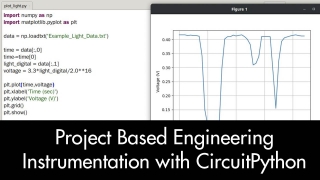
This textbook has been designed with the student and faculty member in mind. First, this textbook goes hand in hand with Engineering Instrumentation taught at the undergraduate level at many universities. The course begins with simple plotting and moves into data analysis, calibration and more complex instrumentation techniques such as active filtering and aliasing. This course is designed to get students away from their pen and paper and build something that blinks and moves as well as learn to process real data that they themselves acquire.
There is no theory in these projects. It is all applied using the project based learning method. Students will be tasked with downloading code, building circuitry, taking data all from the ground up. By the end of this course students will be well versed in the desktop version of Python while also the variant CircuitPython designed specifically for microelectronics from Adafruit. After this course students will be able to understand Instrumentation at the fundamental level as well as generate code that can be used in future projects and research to take and analyze data.
Python is such a broad and useful language that it will be very beneficial for any undergraduate student to learn this language. To the professors using this textbook, 1 credit hour labs are often hard to work into a curriculum and “live” demonstrations in the classroom cost time and money that take away from other faculty duties. I’ve created this kit and textbook to be completely stand-alone. Students simply need to purchase the required materials and follow along with the lessons. These lessons can be picked apart and taught sequentially or individually on a schedule suited to the learning speed of the course. I hope whomever reads and learns from this textbook will walk away with an excitement to tinker, code and build future projects using microelectronics and programming.
The above text is taken from the abstract of the book
